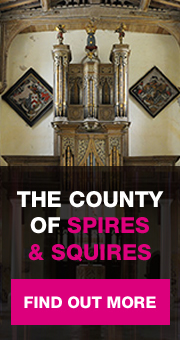Whilst the tower is medieval the church was so re built in the 17th and 18th century and that is it’s overriding appearance. The vestry though was added by Bodley, 1879. Internally the medieval nave and aisles now have 18th century ceilings leading to a pure 18th century chancel. The reconstruction of the church was carried out by William Smith of Warwick between 1737 – 1743; the contemporary plaster work is by John The Isham mausoleum is separated from the chancel by three equally large and bold arches, sparingly decorated with the family’s arms surrounded by deft rococo plasterwork. The room is raised up as it stands above the family vault, the steps to it giving extra emphasis. It was clearly replanned by Francis Smith of Warwick with his spectacular tomb to Sir Justinian Isham (d.1737) in the centre. A huge marble arch soars up containing a pair of obelisks decorated with seven vividly painted coats of arms. The centre is architecturally reminiscent of a grand fireplace (it comes as no surprise to discover that Francis Smith also supplied marble chimneypieces to the Hall). On it stands a very fine bust of the deceased by Peter Scheemakers (1691-1781). His workshops during this period were in St. Martin’s Lane and Old Palace Yard, Whitehall. Coming from Antwerp he had studied in Rome before arriving in England in the late 1720s. He was quick to establish a reputation with his memorial to General Monck in Westminster Abbey and the great Curzon monument at Kedleston which is contemporary with that at Lamport. During this period he also supplied classical busts to Stowe as well as those incorporated into The Temple of Friendship. Here at Lamport, as often the case, he executed two busts of Sir Justinian, one for the Hall and one for the Church. To the left and right are wall tables to Sir Justinian’s father and grandfather, both called Justinian. His father’s memorial, Sir Justinian Isham, Bt (d.1730) was also designed by Smith of Warwick who added a north wing to Webb’s building in 1732 and a south wing in 1741. All three generations of the Stanton family of sculptors, who had their yard in Holborn in London, are represented here. The grandparents, Sir Justinian Isham (d. 1700) is by William Stanton (1639-1705) with its Solomonic columns whereas Elizabeth, Lady Isham (d.1713) with weeping cherubs is by Edward Stanton (1681-1734). The small wall plaque to Mrs James Isham is by Thomas Stanton (1610-1674). The monuments to Elizabeth, Lady Isham is one of the few late 17th century memorials where the agreement for its construction survives. “William Stanton, Stone Cutter … shall make the pillars of the Monument Twisted pillars of the best dove coloured Marble and the Trusses underneath the said pillars likewise of the best dove coloured Marble and it is agreed that the large plate for the Inscription shall be full 2 inches and half thick of the best white marble & the said William Stanton for the fashion of the said twisted pillars is to have four pounds over and above the former bargain … 1699”. The monument cost £64 and was sent down from Holborn in a wagon with Stanton’s man, John Summers, who set it up. You might notice the small rococo wall plaque to Mrs Raynford (d. 1763) by William Cox of Northampton who also supplied chimneypieces for Lamport Hall. This is a fairly recent arrival having been salvaged from nearby Faxton Church which was demolished in the 20th century (the main memorial there was to Sir Augustine Nicholls, (1559-1616) Lord Chief Justice which is now in the V&A. In the churchyard can be found the tomb to Major George Jenkinson d. 1907 by Feodora, Countess Gleichen in the form of a Greek stellae. Elsewhere Countess Gleichen (1861-1922) provided the memorial to Edward VII at Windsor and Diana, the Huntress, which stands in Hyde Park Gardens.
Please refer to the Glossary for any terms in the text that you are unfamiliar with.







